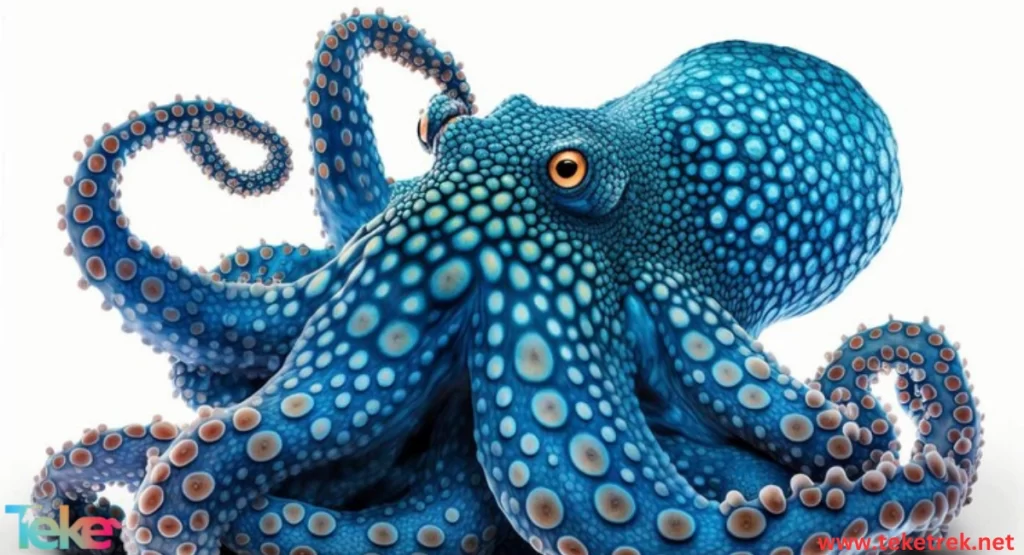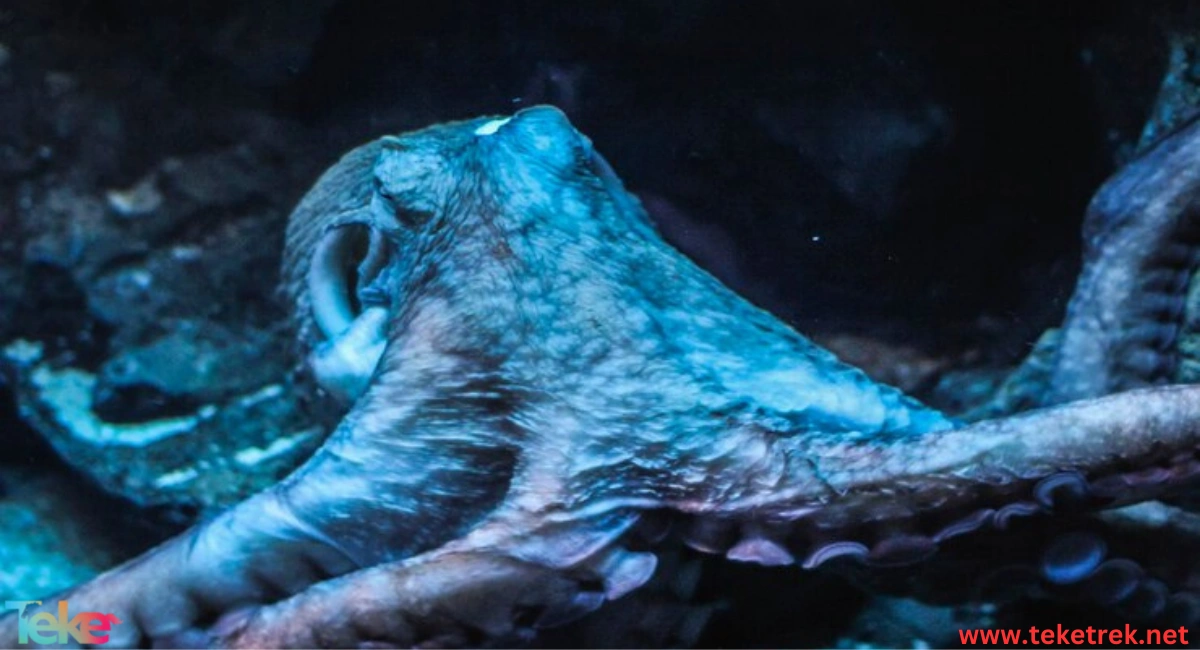The blue-ringed octopus is one of the distinctive aquatic animals, with several different species, including the blue-ringed octopus distinguished by its colors, lifestyle, and defensive mechanisms.
The blue-ringed octopus is one of the most venomous marine animals! If you are interested in learning more about this animal, follow this article with us on TekeTrek.

What is a Blue-ringed Octopus?
- The blue-ringed octopus belongs to the class of highly venomous cephalopods, as its name suggests. These octopuses are characterized by numerous blue rings on their bodies and arms.
- These octopuses use their vibrant colors in the rings covering their bodies as a warning to potential predators. However, unlike other animals like poisonous frogs or velvet ants that display their vibrant colors permanently, blue-ringed octopuses only show their colors when they feel threatened.
- When they feel disturbed or attacked, these animals quickly change their color. They use their muscles to highlight their blue patterns, which are displayed over a yellow or creamy base with darkly pigmented cells beneath the rings, helping to intensify the color.
- Like many other octopuses, blue-ringed octopuses can also use their specialized color carriers to help camouflage themselves. They spend much of their time hidden in crevices to avoid animals that may try to eat them.
- The blue-ringed octopus belongs to the phylum Mollusca, class Cephalopoda, subclass Coleoidea.
Locations of the Blue-ringed Octopus
Blue-ringed octopuses have been found in the Pacific and Indian Oceans. They typically inhabit coral reefs and rocky areas on the seabed, although they can also be found in tide pools, seagrass beds, and layers of algae. These octopuses are usually nocturnal, coming out at night to hunt crustaceans and sometimes small fish.
Some Species of Blue-ringed Octopus
Researchers believe there are about 10 species of blue-ringed octopuses, although not all of them have been discovered yet. The most well-known species include:
- Blue-ringed octopus (Hapalochlaena spp.):
This species reaches a length of about 12 cm, including its arms. It prefers shallow waters up to a depth of 20 meters. It has been found in the waters surrounding Indonesia, the Philippines, Papua New Guinea, as well as Vanuatu and the Solomon Islands.
- Southern blue-ringed octopus (Hapalochlaena maculosa):
This octopus is found at depths of up to 50 meters along the southern coast of Australia, including around Tasmania. It can reach a length of about 22 cm and its base coloration can range from gray and green to creamy, with 50-60 blue rings.
- Blue-striped octopus (Hapalochlaena fasciata):
This octopus is characterized by rainbow-colored blue stripes on its mantle, along with distinctive blue rings on its arms. It reaches a length of up to 15 cm and can be seen in the waters off eastern Australia.
It’s worth noting that these species share similarities in lifestyle, feeding habits, and defensive mechanisms.
Behavior of the Blue-ringed Octopus
- The blue-ringed octopus is not an aggressive animal; it typically hides in crevices or under rocks during the day for protection and only emerges at night.
- These octopuses use their specialized skin chromatophore cells for camouflage. Like most other octopuses, it flattens its body against the seabed to hide from its predators. More importantly, it changes the color of its body to blend in with its surroundings.
- Blue-ringed octopuses inhabit the seabed, sandy, and muddy areas, residing inside empty seashells, bottles, and discarded cans. They only leave their shelter to search for food or mate.

Diet of the Blue-ringed Octopus
What does the blue-ringed octopus eat?
- The blue-ringed octopus primarily feeds on crustaceans, shrimp, and other invertebrates. However, it also consumes injured or live fish if it manages to catch them. This octopus ambushes its prey, seizing and attacking it with its claws before pulling it towards its mouth. It then paralyzes the prey with its venom while piercing its beak through the exoskeleton.
Reproductive Stages of the Blue-ringed Octopus
- The blue-ringed octopus exhibits peculiar sexual behaviors. The mating rituals of these creatures begin with the male approaching the female and caressing her with his modified arm. Mating then occurs, and the sperm is released, concluding with the death of the male octopus.
- Female blue-ringed octopuses lay only one clutch of eggs throughout their lifetime, with each clutch containing about 50-100 eggs. The female protects the eggs under her arms for approximately six months. She dies shortly after the juvenile’s hatch because she does not eat any food during the brooding period.
- The baby octopuses are born small (approximately the size of a pea). However, they grow rapidly and are capable of foraging for their food within about a month. The juveniles reach sexual maturity and become active within a year, being able to mate by the following autumn.
Predators of the Blue-ringed Octopus
The primary predator of the blue-ringed octopus is the sea snake, specifically the greater sea snake. Other predators include whales, dolphins, various species of shore and marine birds. Additionally, this animal is not safe from human predation and is often killed by humans to avoid its harm and toxicity.
FAQ
- Is the blue-ringed octopus venomous?
Yes, the blue-ringed octopus is considered highly venomous. The venom of this octopus contains potent toxins, including a substance called tetrodotoxin, which affects the human nervous system and can cause severe convulsions, respiratory weakness, respiratory failure, and in severe cases, death.
- Can you eat octopus?
It is not recommended to eat the blue-ringed octopus or any type of octopus generally, due to their content of toxins that may be harmful to humans. Although some species of octopus may be safe for human consumption after proper processing, the blue-ringed octopus is considered highly dangerous due to its powerful toxins. Therefore, it is preferable to avoid consuming it to prevent health risks.
- How poisonous is a blue-ringed octopus?
The blue-ringed octopus is highly venomous due to its potent neurotoxin, tetrodotoxin. Even though small in size, it carries enough venom to be deadly to humans, causing paralysis and respiratory failure. It’s considered one of the most venomous marine animals.
- Can you touch a blue-ringed octopus?
It’s not advisable to touch a blue-ringed octopus. Even though they may appear small and harmless, they are highly venomous, and their bite can be deadly. Handling them without proper expertise and precautions can lead to severe envenomation and potentially life-threatening consequences. It’s best to observe them from a safe distance in their natural habitat.
In conclusion
In conclusion, the blue-ringed octopus (Hapalochlaena) is among the most fascinating creatures in the ocean world. This octopus is distinguished by its captivating blue color and distinctive rings, along with its astonishing behavior. Despite its small size, its potent venom makes it a dangerous creature that should be handled with caution. Recent studies show that this octopus exhibits exceptional hunting skills and self-defense mechanisms, highlighting the diversity and remarkable adaptation of marine life. We must preserve these wonderful creatures and coexist with them responsibly, as they are an integral part of marine ecosystem balance.






